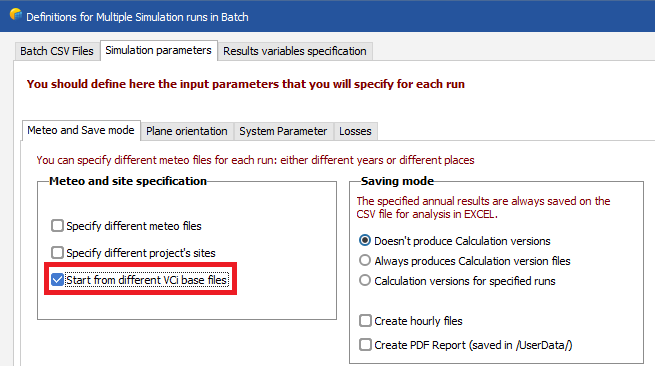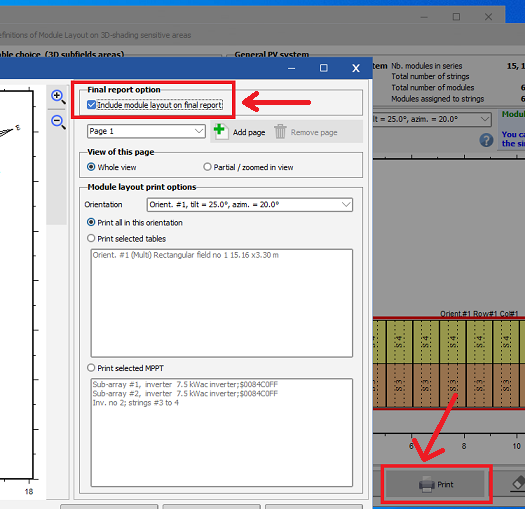-
Posts
101 -
Joined
-
Last visited
Posts posted by Hizir Apaydin
-
-
Dear jammyc,
Thank you for your suggestion. Such functionality is not implemented yet in PVsyst.
However the batch mode tool may partially meet your needs and looks like what you are describing.
Indeed, you can specify different variants and parameters as input of the batch mode and get the predefined output variables in a CSV file

We have taken into account your suggestion and we will study it.
Thank you.
-
Hi Julmou,
Thank you for this detailed explanation of you pricing strategy. Unfortunately, the production-dependent pricing is not implemented in PVsyst. only time-dependent pricing is available. We have taken note of your request and will study it with interest in order to include it in a future version.
Kind regards
-
Dear Mark Norman,
There is indeed a display issue with the compass for projects in Southern Hemisphere. This will be fixed in the next version. All the calculations are correct.
Kind regards
-
Dear Fawaz,
After clicking on"Print" from the Module Layout, you can check "Include module layout on final report" and configure how you want it to be displayed:

Regards
-
Dear Fawaz,
The company name is automatically filled from the company name present in the license file.
If you want to change your license's company name, please send a mail request to admin@pvsyst.com
Kind regards.
-
Dear Julmou,
The discount rate represents the yearly loss in value of your money over the life of your project. For example, if your initial investment is 100$ and the final value of your project is 150$ after 20 years, your project may not be profitable if 150$ after 20 years represents much less than 150$ of today.
There is no specific rule for the discount rate calculation. It implies a detailed analysis taking into account the inflation, the interest rate of the market, and some financial and ecomomical projections. If you want to estimate a simple value, you could use the interest rate of the market, and add a safety margin. For example, if your bank proposes you an interest rate of 3%/year for a deposit on an account over a period of 20 years, you could set a discount rate of 3.5% in PVsyst (3% + 0.5% safety margin). This means that with a positive NPV at the end of your project of 20 years, your photovoltaic investment would be more profitable than putting your money on an interest-bearing deposit account for the same period.
Regards.
-
On 3/16/2022 at 7:07 PM, jammyc said:
Hi Hizir,
Thanks for the response.
For various reasons I've only just had chance to have a quick play with a test project, but if I understand correctly, in batch mode:
Installation costs:
- Anything listed under "PV modules" is scaled by the qty of modules, regardless of module STC rating
- Anything listed under "Inverters" is scaled by the qty of inverters, regardless of inverter rating (etc)
- Everything else (other components, studies etc) is fixed and does not change for the entire batch
Operating costs:
- All OPEX is fixed
It looks like the quantity for inverters and module sub-costs is automatically adjusted to be equal to the inverter and module count even for the rows that are not greyed out?
Dear jammyc,
Yes that is correct. All costs related to modules and inverters are automatically updated from the system. The other installation costs and the operating costs remain fixed as the price variation may not be proportional to the module or inverter quantities (for example, multiplying the number of modules by 2 does not necessarily multiply the "environmental studies" or the "insurance" costs by 2). For a financial performance comparison between different sizes of system, manually performing the economic analysis and reviewing all individual costs for each system would be more precise than using the batch mode comparison.
Regards,
-
Hi,
Two part question:
1) How does PVsyst update costs if the project parameters (e.g. qty or size of modules) subsequently changes? Does PVsyst "remember" whether a cost was input as XX absolute, XX/Wp or XX/m²? What about if I define a custom cost item?
2) Is this also applied due to changes in batch mode, or are they lumped somewhere?
Spurious example, it is convenient to input the grid connection costs as a fixed XX, inverter price as X/unit, but module price as X/Wp. If I then change both the qty inverters and qty modules in batch mode, will the costs change as I expect?
I have historically carried out the economic evaluation as a post-simulation process, so apologies if this is obvious and I've missed it.
Thanks in advance
Dear jammyc,
The price type selection (global, by wc, by m2) is applied for all the costs you defined.
Let's say you define a fixed grid connection cost of 10000$. Then you want to define module price per Wp.
So you change from "Global" to "by Wp". This will automatically transform the grid installation cost price from 10000$ to a price per Wp (for example 1$ if you have an installation of 10000wp). All other costs you defined are also updated to a "by Wp" cost.
However, when you change your quantity parameters in PVsyst system Window, only system dependent costs are automatically updated in the economic evaluation (module, inverters and battery costs according to quantity).
None of the other costs are changed, even if you defined them per wp or per square meter. If you defined a custom cost item, its amount is not changed when resizing your system.
The new cost calculation for system dependent cost is done by quantity. Let's say you have defined a module cost of 1$/wp in the ecomomic evaluation. If you change your module quantity in the system, the price calculation is done according to quantity ("Global option"), even if you selected "by Wp" to initially define it. But the cost will still appears as "by wp" in the ecomomic evaluation window, but its value should have been modified.
Regarding the batch mode, the economic evaluation parameters are not modified. However you can select economic evaluation parameters as output parameters of the batch.
The updated costs will then appear in the results column of your resulting excel file. You have to check the "Number of modules" or "Number of inverters" parameters in batch simulation input parameters if you want to see the economic impact of changing these quantities in the batch output results.
Kind regards
-
My Output files have Decimal Commas instead of Decimal Points even though "Decimal point" is selected under the "Decimal separator" setting. Is this a bug with version 7.2.11?
Dear msykes,
We have noticed an issue with PVsyst 7.11 when selecting "Windows settings" for "Thousand Separator for money amounts". If this is your case, could you try changing this to another value ("Nothing", "Whitespace", "Comma" or "Apostrophe").
If the problem still remains, please contact support@pvsyst.com.
We thank you and remain at your disposal for any other request that might be required.
-
I had a license for my PVsyst version 7.2 on an old computer. When I tried to change it into my new computer the following message appeared "License has been blacklisted on this computer". It happens because I had already installed the license on this new computer in the past, but due to some performance problems I had to resend it into my old computer. Now that I have solved my performance issues, I can not get the license activated on my new computer again. In parallel, looking at my old computer, when I try to deactivate the license I find another problem, the software asks me to contact the online support, once the license can not be transferred. I've already sent an e-mail to the online support 6 weeks ago, but no answers so far ...
Dear Bertolim,
Could you please send your request directly to support team by providing your company and license details from this form: https://www.pvsyst.com/contact/
Thank you.
-
Hi everybody,
I have to design a photovoltaic system on a roof of a building of circular shape and I'd like to know if there is a method to define a photovoltaic zone of circular shape.
I looking for your precious answers.
BS,
Roberto Bissanti
Dear Roberto Bissanti,
You can either create a polygonal PV plane from 3D scene menu "Create>Polygonal plane" or create a "Free zone" from zone editing tool of the 3D editor.
In both cases, you will have to manually create multiple points to delimit your circular area, there is no predefined circular zone edition tool.
-
-
Dear Kateryna,
There is indeed an issue with polygonal fields in PVsyst 7.2.6 and the fix will be available in the next version.
In the meantime, here is a workaround to avoid the error:
- Open a project variant that does not contain polygonal fields
- Open “Near shadings” dialog
- From the top menu, select “View”, “View options”, and uncheck “Show modules”.
You will then be able to reopen shading scenes containing polygonal fields.
Kind regards
-
Hello,
I have a consumption index in the form of a "10 minute point". I would like to use this consumption index to estimate the photovoltaic power needed to obtain a viable economic model.
In what format and how should I implement this index?
For information, this is a consumption profile from the French network manager: Enedis
Thank you in advance for your help.
T.Geb
Dear T.Geb,
You can import into PVsyst an hourly load profile from a CSV file.
The consumption index provided by Enedis contains 6 values per hour (consumption on 10-minutes periods).
You will have to merge ten minutes values in hourly values and import the resulting CSV file in PVsyst from "Self consumption" / "Load values from CSV file" / "Choose CSV file" / "Browse" and select your hourly CSV file.
The template provided by PVsyst (available under C:\Users\Username\PVsyst7.0_Data\UserHourlyParams) is an hourly CSV containing all the hours of the year in the first column, and the corresponding hourly consumption in the second column.
You can have more details about this feature on this page https://www.pvsyst.com/help/load_file.htm
Kind regards
-
Hello everyone
I'm performing an economic evaluation in PVsyst. But i have a question about the global installation cost per module/per inverter and the cost for grid connection.
What exactly should be entered here?
Kind regards
Yoline
Dear Yoline,
Thank you for your interest in the economic evaluation tool of PVsyst.
You can either define your costs in detail by setting the price of each module, inverter, structure under module, wires etc... or define them globally.
For example, a photovoltaic system installer can give you a global price depending on the size of your installation, without giving you the detail of each cost.
He can tell you that the global installation cost will be 200$/module, including components, wiring, transport, manpower etc. If your system contains 100 modules, your total installation cost will be 20 000$, without worring about the details.
If you define all your prices individually (modules, inverters, wires, transport, installation), you don't have to set "Global installation cost per module", nor "Global installation cost per inverter", you can delete these costs from the list.
Regarding the "Grid connection cost", this is the initial cost of connecting your photoltaic installation to the grid system in which you will inject your electricity. This includes the cost of the equipments needed to physically connect your system to the grid, and also several administrative costs (contract establishment, taxes etc...). This cost depends on the location of your installation (you will have to pay a higher grid connection cost if your photovoltaic installation is located in a place hard to reach, far from high voltage lines etc...) and also depends on the country (in some countries you can have high administrative fees).
In some countries, you can also have to pay a yearly subscription or tax, in order to have the right to be connected to the grid. You can set this cost in "Annual connection tax" of "Tarrifs" tab.
Anyway, the default list of costs provided by PVsyst is a fully customizable template. You don't have to set the costs which are not relevant for your project. You can add specific costs to your project, delete or modify existing costs.
For more information about the economic evaluation, please have a look at this specific video tutorial:
Kind regards
-
Hello,
I had a problem with my HD where the program's license was installed. Now I have a new HD, but I have to uninstall the license from the old HD. How can I do that?
Dear customer,
Please contact support@pvsyst.com and provide your customer ID and your license number in order to get assistance on this issue.
Kind regards.
-
Hello,
You can download PVsyst 7 from our website :
https://www.pvsyst.com/download-PVsyst/
Best regards.
-
Hi there!
Would it be possible if you can please explain to me about the declining balance option in the new Financial Parameters section of the economic evaluation parameter in Grid-Connected Project design. The help file is useful as it gives me a background as to how its calculated, but it mentions the use of a "Depreciation Coefficient".
What is this coefficient dependent upon on? Where can I find further information or examples of typical values that you would insert here?
I was doing some research online, and it came up with French accounting depreciation coefficients - is this what it is referring to?
I am looking to undertake some system design based in Australia so I am not sure how to apply this type of coefficient to my location...
Thanks
Ryan
PS: Thanks to PVsyst for releasing version 7 - it looks really great!
Dear Ryan,
The declining balance option permits to accelerate the depreciation in the first years of the project according to a depreciation coefficient.
This coefficient is entirely dependent on the taxation system of your country and the choosen taxation option, there are no typical or standard values.
As examples, in France, for an amortization of 3-4 years, this coefficient is equal to 1.25, 1.75 for 5/6 years, and 2.25 for more than 6 years.
In USA, this coefficient is defined in MACRS (Modified Accelerated Cost Recovery System), it depends on the system, company type ect... A common method is the "Double Declining Balance" method in which the coefficient has a value of 2.
We don't have knowledge about the Australian tax system, but an accountant must know which method is applied for your system and what is the value for this coefficient.
Here I found some information about depreciation methods in Australia : https://help.sap.com/viewer/2754875d2d2a403f95e58a41a9c7d6de/1811/en-US/2cbac733722d10148835ebe587377c69.html
Best regards,
-
Hello,
I have a problem. I have set up a grid connected system in the project design tool. I would like to put a value euro/kWh to the energy from the grid to the user and I cannot find it.
Thank you in advance for you time!
Dear Nouslas,
You can set up the electricity cost only when self-consumption is defined in order to calculate the "self-consumption economy".
This is done in "Self-consumption saving" in "Tariff" tab from Economic Evaluation tool.
When no self-consumption is defined, the cost of bought electricity is not taken into consideration for system profitability calculation, that's why the field for cost of electricity from grid would not be available.
Best regards.
-
PVsyst 6.8.4 running on Windows 7 in VirtualBoxVM
Hello,
When I use Economic Evaluation tool and enter a value in the Financing fields that are more than 9 digits long I get an error "Number Conversion error". This does not happen for 8 or fewer digits.
Example:
Own Funds = 999999999
Error = Number conversion error: "999'999'99"
Also I can't enter more than 11-digits. PVsyst truncates the number to 10-digits. can this limitation also be removed?
Dear Mr Sang Bui,
This limitation will be increased in a future version of the software.
Thank you for your interest in PVsyst.
-
Hello,
The inflation rate is applied after first year :
OPEX year 1 : 100 GBP
OPEX year 2 : 100 + (100*10/100) = 110 GBP
OPEX year 3 : 110 + (110*10/100) = 121 GBP
OPEX year 4 : 121 + (121 *10/100) = 133 GBP
OPEX year 5 : 133 + (133 *10/100) = 146 GBP
Thus the average OPEX on project life is (100+110+121+133+146) / 5 = 122 GBP
Regards
-
Hello,
It would be very helpful if LCOE calculations are introduced in the software and visible in financial report.
We analize more and more our projects using this parameter, since Feed-in-tariffs are not available for some new installations in our part of the world and this is a tendency more and more.
As a start at least simple formula could be introduced, considering mainly CAPEX, OPEX, energy for 25 years with the degradation.
Since we have all needed parameters in the software probably it is posible.
We aim to optimize the systems in order to reach lowest LCOE, which is not always highest energy output - for example for specific project an east-west fixed system could achieve almost same LCOE despite the significant lower production, but due to the lower CAPEX - cheaper structure, high ground coverage ratio, same fixed expences - project development, roads, fences, etc.
Also it would be very helpful if there is instrument to calculate LCOE as function of selected parameter:
- calculate LCOE if AC/DC ratio of inverter is changed
- if tilt is changed
- if project location changes
etc.
Best regards!
Dear Veselin,
We thank you for your suggestion.
Actually the cost of energy is visible in the economic evaluation tool and also in the report. The only difference with the strict LCOE definition is that it does not take into account the discount rate (net present value). But the strict LCOE value will be available in a future version of PVsyst. As you suggested, we are also planning to include economic optimizations in simulation according to some defined parameters.
We thank you for your interest in PVsyst.
-
Dear Tuomas,
Which version of PVsyst are you using ?
Could you please export the project you are working on (Menu>File>Export Project) and send it to support@pvsyst.com in order that we can investigate about the issue ?
Thank you.










PVsyst crashes when loading a "grid unavailability profile"
in Problems / Bugs
Posted
Dear Julmou,
This issue has indeed been fixed in the last version of PVsyst (7.2.18)
Kind regards.
Hizir